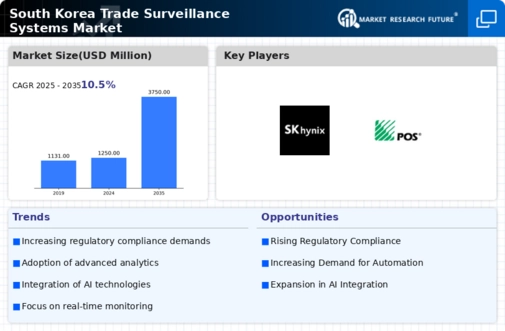The trade surveillance-systems market is currently characterized by a dynamic competitive landscape, driven by the increasing regulatory scrutiny and the need for enhanced compliance measures across financial institutions. Key players are actively pursuing strategies that emphasize innovation, technological advancement, and strategic partnerships to maintain their competitive edge. Notably, companies such as Nasdaq (US), Thomson Reuters (CA), and FIS (US) are at the forefront, leveraging their extensive technological capabilities and market presence to shape the competitive environment. Nasdaq (US) focuses on integrating advanced analytics and machine learning into its surveillance solutions, while Thomson Reuters (CA) emphasizes the development of comprehensive compliance tools that cater to the evolving regulatory landscape.
In terms of business tactics, companies are increasingly localizing their operations to better serve regional markets, optimizing supply chains to enhance efficiency, and investing in digital transformation initiatives. The market appears moderately fragmented, with several key players exerting considerable influence. This competitive structure allows for a diverse range of offerings, enabling firms to cater to specific client needs while fostering innovation through competition.
In October 2025, FIS (US) announced a strategic partnership with a leading South Korean financial institution to enhance its trade surveillance capabilities. This collaboration aims to integrate FIS's advanced analytics tools with the institution's existing systems, thereby improving compliance and risk management processes. The strategic importance of this partnership lies in FIS's ability to leverage local market knowledge while expanding its footprint in the region, potentially leading to increased market share.
In September 2025, Thomson Reuters (CA) launched a new suite of AI-driven surveillance tools designed to detect market manipulation and insider trading more effectively. This initiative reflects the company's commitment to innovation and its proactive approach to addressing regulatory challenges. By harnessing AI technology, Thomson Reuters (CA) positions itself as a leader in the market, likely enhancing its competitive advantage and attracting new clients seeking robust compliance solutions.
In August 2025, Nasdaq (US) expanded its trade surveillance offerings by acquiring a technology startup specializing in blockchain analytics. This acquisition is strategically significant as it allows Nasdaq (US) to incorporate blockchain technology into its surveillance systems, thereby enhancing transparency and security in trading activities. The integration of such cutting-edge technology may provide Nasdaq (US) with a unique selling proposition, differentiating it from competitors and appealing to a broader client base.
As of November 2025, the trade surveillance-systems market is witnessing trends that emphasize digitalization, AI integration, and sustainability. Strategic alliances are increasingly shaping the competitive landscape, enabling companies to pool resources and expertise to address complex regulatory requirements. Looking ahead, competitive differentiation is likely to evolve, with a shift from price-based competition to a focus on innovation, technological advancement, and supply chain reliability. Firms that can effectively leverage these trends will likely secure a stronger position in the market.













Leave a Comment